PCB edge plating
what is edge plating in pcb manufacturing?
Edge plating can also be called as Metalized edge plating, border plated, plated contour, side plating and castellation in PCB industry. The electroplating coating ranges from the top surface to the bottom surface of the PCB board and is the encapsulation of the edge of the PCB board. Plating can be performed on single-axis or multi-axis edges of PCBs. Often used to improve EMI shielding for high-frequency designs, and to improve chassis grounding for signals. According to IPC standards, When it comes to the definition of edge plating, there not exist an expressly stated definition. But it is generally accepted as a process of being plated with metalized materials. Electroplating materials are not only copper, there are many other kinds of materials used for PCB plating, such as gold, silver, tin and nickel.
PCB edge plating is also divided into three different types:
- Regular plane edge plating;
- Wrapping edge plating;
- Tooth edge plating.

Specialized equipment and professional and well-trained staff members are necessary for Printed Circuit Boards edge plating. The interior power planes coming to the edge of the circuit boards and the short circuit of edge plating would be caused by the nonobservance of working procedures. Edge plating is a method of enabling secure and strong connection realized in the Printed Circuit Board, also a remedy used to cut down the chance of costly board failures. In addition to this, edge plating can ameliorate chassis ground in systems and also refine Electromagnetic Interference shielding of high frequency designs.
For multiple axis boards, same as single-axis boards, edge plating is required to be implemented for all four edges. When the rout path is realized before the circuitry features of the PCB are metalized, there will exist edge plating. And sometimes, it also be described as “plated rout”.The size of every boards, the magnitude of edges of the boards, and whether the boards will be delivered in a multi-up array will be the design core of carrying out this technology. For the routing requirements, stability of the materials, which are used in fabricating the printed circuit boards, also plays a vital role in it. In order to ameliorate the structure of panel interior parts used to carry the parts during the process of manufacturing, not being the standard glass-reinforced FR-4 type materials may need an alternative routing design. An array, referred to the intact parts after being processed inside the carrier panel, is used for assembly and manufacturing. And under some circumstances, it requires the development of tabs for edge plating. Tabs might not be asked for stability for a single edge which needs edge plating.
Surface treatment of PCB edge plating.
Under the condition of providing electrical connections, the surface finish of PCB edge plating can be the level of ENEPIG ( Electroless Nickel Electroless Palladium Immersion Gold), ENIG (Electroless Nickel Immersion Gold) and HASL(Hot-air Solder Leveling). Click to learn more about PCB surface treatment process. The PCB edge is used for printed circuit board assembly by side plating.
Now the next step, let’s see some introduction of these three kinds of edge plating surface finish.
- The fist type: ENEPIG ( Electroless Nickel Electroless Palladium Immersion Gold)
The structure of this kind of plating materials owns a copper-nickel-palladium-gold layer, which can be directly bonded to the plating by wires. Just as in ENIG, the last layer of gold is super thin and also the gold layer is soft. Because of this characteristic, the palladium layer might be exposed by deep scratches and undue mechanical damages. - The second type: ENIG (Electroless Nickel Immersion Gold)
In this type of plating material, nickle serves as a barrier layer for components to be soldered between the thin gold surface and the copper layer. - The third type: HASL (Hot-air Solder Leveling)
HASL can be selected as an entry level plating option, because of its reasonable price and availability. But HASL is not that reliable compared with other plating materials.
The weaknesses and strengths of these three types of plating materials can be revealed as the table below.
| ENEPIG | Strengths | Convenient for the process of soldering and bonding wires. Fit for fine pitch. Even and smooth surface. The lowest corrosive extent in all commercial plating materials. Bonded by wires (AU&AI). |
|---|---|---|
| Weaknesses | Costly. It’s difficult for materials to wet and solder due to palladium layers. Separate processing line might be needed. | |
| ENIG | Strengths | Even and smooth surface. Bonded by wires (AI) PTH holes can be plated easily. Broadly available. Be soldered easily. Fit for fine-pitch parts. Prevent the occurrence of mechanical damage |
| Weaknesses | To the disadvantage of rework and many times of assembly processing passes. Might be costly. Black pad syndrome may occurs which refers to the phosphorous infiltration between nickle layers and gold. Signal losses can be created by rough interface at high frequencies. | |
| HASL | Strengths | Low-priced. Be able to repair. |
| Weaknesses | It’s less useful for small size SMD components due to uneven surface. Thermal shock can cause damages. It’s hard to solder because of poor wetting. |
Why edge plating on PCB?
At the present time, PCB Electroplating technology has been widely applied in many different industries, particularly applied in industries which require strong and secure connections.
The improvement of the reliability and the quality of Printed Circuit Boards (PCB) can be realized by improving delivered current conduction in circuit boards. If they want the components to be capable of operating like their design, the right level of conduction is indispensable. It can also prevent the more frail PCB edge connections from damage. Here’s what you can get to help when edge plating your PCBs.
Benefit one: Thermal Distribution.
The most prominent benefit of edge plating is that it can support thermal dissipation. Particularly when signal speeds increase, the circuit board will produce a great deal of heat, which is generally conducted to the interior ground plane and then evenly distribute all over the board by thermal vias. Because of the connection between the edge plating and the ground plane , it’s easy for the heat to distribute outside the board by the metal edge. At the same time, if the components is overheated, they may fail and have the possibility of leading to vitally potential damage to the printed circuit boards. In the wake of customer’s requirements of multi-functioned printed circuit boards (PCB), it’s inevitable to closely pack more components onto small circuit boards. Effective dissipation become the top priority, which can conduct overmuch heat going away from temperature-sensitive components. Too much heat will impact the reliability and performance of the printed circuit boards.
Benefit two: Signal and power integrity.
PCB edge plating can boost signal and power integrity. As the development of PCB boards becoming complicated, signal integrity needing more complex layouts and faster connection becomes a new requirement. For the equipment required, PCB edge plating can be seen as a straightforward process, but the order of the operating process might be different. The power and signal integrity of the PCB boards can also be boosted by reducing the level of electromagnetic interference. The improvement of current-carrying capabilities and the extra shielding of high-speed circuitry can be achieved by the extended grounding, which is provided by the PCB edge plating.
Benefit three: Electromagnetic compatibility.
Electromagnetic interference(EMI) can be generated at multi-layered circuit boards by the current, which is carried by the power and ground planes. This interference can cause radiation outside the system, and also lead to circuit boards exceeding the EMC standards that need to be met. Encapsulating the PCB board’s edges in the way of metal plating is an effective method of preventing electromagnetic interference form radiating.
Benefit four: Structural integrity.
Adding extra metal on the sides of PCB boards, which strengthens its rigidity and strength, can reduce the possibility of suffering physical damage because of being frequently used. The better support that offers the condition of sliding into the metal casing and frames of electronic system can be provided by the metal sides of PCB boards. During its use and handling process of PCB, accidental physical damages can be avoided by the way of edge plating.
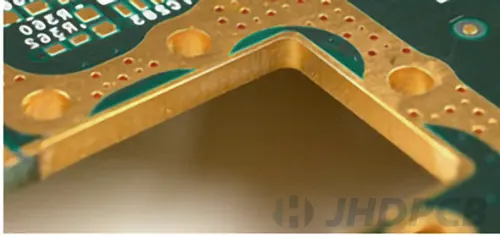
PCB side plating process flow.
Until now, metallization and non-metallization are two main ways to design PCB board edge. As the increasing development of technology, more and more customers choose PCB metal edge as their primary choice. As a result, the quality of metal edge that can cause a direct impact the use of products becomes the central issue for customers and manufacturers.
Next, let’s figure out the process of metalized edge plating.
- Drilling -> Milling metal slots -> Removing dirt -> Electroless copper plating.
Before the process of through-hole plating, the outer contour that will be metalized must be milled. Because during this manufacturing procedure, there exists the metalization of the edges. The anticipative surface finish is eventually applied to the PCB board edges after the procedure of depositing copper. The surface ENIG is strongly recommended by us.

Beyond that, let’s know something about the technical features of gold plating, which refers to the process of plating with gold and electroplating the side walls of the PCB boards with nickel and gold. Its features include as follow:
- Because of etching, the etching groove extending along the pattern to be coated with gold on the side walls, can be formed on the copper surface of the PCB boards. Then the copper layer requiring to be coated with gold is exposed.
- A dry film is pasted on the copper layer, and at the same time creates an opening. The opening is equivalent to the area of the etching groove and copper plate, which requires to be covered with gold.
- The PCB circuit boards are electroplated with gold and nickel so that the layer of gold and nickel and gold is plated on the area of the copper plate and side walls.
- During the process of plating the PCB circuit boards with gold and electroplating with nickel and gold, the distance length that starts from the circumferential edge of the opening to the circumferential edge of the copper plate is 4 mils.
In addition to the above content, we need to know the precise handling of the boards is the basic requirement for edge plating. In the meantime, manufacturers confront with some challenges that mainly focus on creating a lifetime adhesion for the plated materials and preparing the edges to be plated. The process of fabricating PCB circuit boards, this requires absolute control for it to limit latent damages in edge plating and PTH. The creation of burrs is the the most vital concern and we should pay attention to it. Because it can limit a lifetime adhesion of the PCB edge plating and cause the discontinuities in PTH walls. JHD’s strict quality control system can minimize defective rate.
PCB edge plating guidelines.
JHD’s PCB plating guidelines will be elaborated from the following sections: design rules, Surface Treatment Panel Design Requirements, and other considerations.
Design rules
Part one, design rules involving design rules for overlapping copper area, design rules for PCB plating edges and design rules for the thickness of PCB edge plating.
(1) Design rules for the overlapping copper area.
The overlapping copper must be used to define the metalized area in the layout file in order to make sure the fabricability of the PCB edge plating. About this aspect, we have three main points we should know combined with Figure below.
- The overlapping length is at least 0.50mm;
- The connected copper must be defined in at least 0.30mm on the connection layer;
- The minimum number of gap between the copper and the outer contour is 0.80mm on non-connected layers.
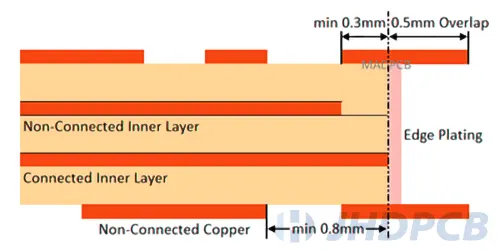
(2) Design rules for PCB plating edge.
It is required that the surface and the edges of the panel all should be encapsulated by edge plating. As you can see in the image below, the minimum length required to cover the surface is 0.015”. For the adhesion of the edge to the plating and interior processing, a wrap-around is needed. The wrap-around is required for internal processing and adhesion of the plating to the edge. In addition to this, from image below, you can tell the minimum length of a feature being placed to the wrap around plating is 0.010”. And also, for an adjacent routed feature, the required length is 0.010”.
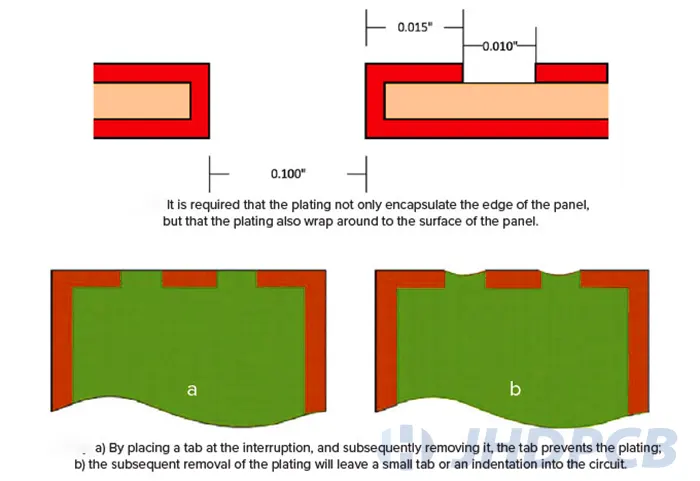
In normal cases, the plating along the total edge of the PCB circuit board is continuous. But the plating can be interrupted with two means.
- You can place a tab on the break and then erase it. The function of the tab is to prevent the process of plating. The first mean can be used under the condition that the minimum plating interruption is 0.200”.
- Plating can also be interrupted at the final wiring stage. A small indentation or a tab on the PCB circuit can be leaved due to the later removal of the plating. The second method can be used when the minimum plating interruption is less than 0.200”.
(3) Design rules for the thickness of PCB edge plating.
The first important thing we have to know is that the accepted and typical thickness values of PCB plating is around 100 micro-inches. The minimum thickness value for OSP and immersion silver can be 10 micro-inches. In addition to this, there exists two reasons for the significance of the thickness of plating materials.
The first reason is that the minimum plating thickness of every single IPC product class have been specified by IPC-2221A standard. Your products can meet any standards of IPC product classes, only when your plating thickness meets their specifications.
The second reason is that its losses can be affected by the thickness value of PCB plating. Under low frequencies, its losses cannot be affected by the thickness, such as under sub-GHz radios and low-speed digital signals. The loss problem occurs at mmWave frequencies, such as 24 GHz and higher. Under this situation, its losses are obviously affected and increased by the copper roughness. The extent of roughness when the signal propagates can be determined by the plating thickness. And the plating thickness can be revealed in the skin effect resistance.
Surface Treatment Panel Design Requirements.
- The orientation of the long side of the edging slot must run parallel to the direction of the long side of the rear panel (the running orientation of the tin spray is parallel with the orientation of the edging slot).
- If the manufacturer receives orders that do not meet the requirements mentioned above, the customers will be suggested and required to use non-sprayed surface processes, such as copper-nickel plating or gold.
Other matters needing attention
- The signal transmission or the customer soldering can be affected by the large position of the antenna on the gold pad.
- The short circuit can result from the connection between the wires on the boards and the inner edge pad.
- The handling of the stamp, at the edging groove, must be completed at the second process of drilling.
- It’s impossible to achieve a continuous metalization of the outer edges when the individual PCBs are manufactured as a panel through process-related fabrication. In addition to this, metalization can also not be applied in the small panel bridges.
- It’s required that solder mask can cover the side plating metalization.
When you are ready to purchase a batch of circuit boards, you first need to confirm whether the electroplating process is necessary. In addition to this, you also need to consider the tolerance capability of the manufacturer that can plate the edge of the PCB. JHD has the ability to complete the plating tolerances required by most industries. At the same time, you should clearly indicate where edge plating is required and where surface finish is required, either in the Gerber file or in the mechanical layer of the fabrication drawing.
Application Scope and Limitations of Edge Plating.
We have known edge plating has four significant benefits, involving thermal distribution, electromagnetic compatibility, signal and power integrity, and structural integrity. These benefits enable edge plating accepted and common in many industries. If you pay attention, you will find that PCB side plating can be applied in many cases as follow.
- Enhance the electromagnetic compatibility of PCBs (namely, PCBs’ current-carrying capabilities.
- Fulfill a better support of connection between board to board and housing connection.
- Provide edge protection and connection.
- Combat the leaking and the radiation to the edges of the boards, which come from electromagnetic radiation.
- Improve the fabrication outcomes by edge soldering, which exists on the plated sides.
Limitations of edge plating.
As we talked about above, the precise handing of the PCB circuit boards is highly required in PCB edge plating. A little mistake can trigger some problems, such as the creation of burrs and the phenomenon of copper peeling. And then the two situations can cause a big hazard. Beyond the specific understanding of PCBs’ application range, now let’s take a look at some limitations of PCB edge plating, which are signed before the fabrication process.
- Copper peeling: The reason for the copper peeling is that the plating on the great substrate surface is short of adequate adhesion strength. The tricky problem can be resolved by making the surface rough by means of using proprietary and chemical ways. Then, for preparing the next plating of the surface, we employ direct metallization with a higher copper bond strength.
- Burrs: Particularly on castellation holes, burrs are often formed during the final machining process of PCB edge plating, namely the milling process. For this problem, we employ the specific and modified process flow to polish down the feature’s edges.
- Some gaps in placing rout tabs are required. The reason is that the manufacturer cannot plate the whole length of edge due to the need of fixing the circuit boards within the PCB prototype’s production panel.
- Fabricating boards with edge plating requires routing at the outlines that require edge plating before starting the through-hole plating process. This rules out V-cut notches on circuit boards that require edge plating.
Why does the PCB side plating peel off?
The phenomenon of copper wire peeling of PCB circuit boards happens occasionally during the process of circuit board fabrication. The process defect can compromise the quality of PCB circuit boards. The following factors may cause the side plating to peel off:
Factors in PCB manufacture process and assembly.
- The copper foil appears the phenomenon of being over-etched. On the market, single-sided galvanization and single-sided copper plating are generally used in electrolytic copper foil. The length of galvanized copper foil, more than 70um, occurs the copper wire to shed often. For galvanized copper foil and Single-sided copper plating equal or less than 18um, It’s not going to happen copper stripping.
- The separation between the copper wire and the substrate was created by external mechanical force due to a local collision during the PCB process. The drawback of this process is that the direction of the line is skewed. Then the distinct distortion or scratches will be created by the dropped copper wire in the same direction. The regular copper foil matte side can be seen by peeling off the copper wire, and the normal copper foil peel strength and no side corrosion defects can be seen as well.
- The illogical design of PCB circuit can cause peeling. The over-etch will happen when a thin circuit is made with thick copper foil. And the copper will be discarded.
- Insufficient surface activation can cause peeling. The term “activation” means the process of removing the oxide layer that exists on the surface of most metals. Oxides can be eliminated by appropriate surface treatment. This step also can eliminate some residues from cleaning products, like acid, salt, soap and alkali. These remnants can curb the coating adhesion.
- Overmuch coating thickness can lead to peeling. A too-thick coating will be brittle. The coating might peel when this part is collided during PCB assembly or at the time a collision between the part and a heavy object occurs during the transport process.
- The peeling can be caused by a current interruption during the process of plating. Bad electrical contact and current interruption during the process of plating are two reasons for adhesion problems and peeling. It is suggested to start the plating again when there exists a long period of turnoff and interruption.
- The lower bath temperature can be one reason for peeling. Maintaining the proper temperature is required during plating. The avoidance of stratification and the persistence of a consistent temperature can be achieved by agitating the electrolyte plating solution when a large plating tank is used.
- The high level of bath contamination can lead to a bad performance of adhesion, such as trivalent and iron. The generally normal manifestation is peeling.
Factors in the laminate process and raw materials.
- Under normal cases, the combination between the copper foil and prepreg can be completed through a no less than 30-minute hot-pressed process of the laminate. Because of this, the bonding force between the substrate and the copper foil cannot be affected by the lamination. The outcome that the bonding force between the substrate after lamination and the copper foil is inadequate will occur when the copper foil is destroyed or the PP is contaminated during the laminated process of the laminate. This situation can render the copper wires peel. But a truth you can find is that the peeling strength of the copper foil around the test line is normal.
- Normal electrolytic copper foils refer to copper-plated or zinc-plated products. The appearance of abnormal peaks during the process of fabricating or being galvanized or copper plated shows the poor plating dendrites. This condition can lead to the inadequate peeling strength of copper foil itself. The copper wires will peel when receiving the externally strong collision even after the poor foil-pressed sheet is made into a PCB. This situation causes the copper wire to peel. And there is no apparent side erosion when you observe the matte side of the copper foil, which refers to the side that contacts the substrate. However, the peeling force of the whole copper foil will be very awful.
- Bad suitability between resin and copper foil can lead to the inadequate peeling force of the sheet-clad metal foil and the occurrence of copper wires peeling when it is inserted during manufacturing laminates.
When you are ready to purchase a batch of circuit boards, you first need to confirm whether the electroplating process is necessary. In addition to this, you also need to consider the tolerance capability of the manufacturer that can plate the edge of the PCB. JHD has the ability to complete the plating tolerances required by most industries. At the same time, you should clearly indicate where edge plating is required and where surface finish is required, either in the Gerber file or in the mechanical layer of the fabrication drawing.
What is Wrap Around Edge Plating?
Sometimes, wrapping the plating around the PCB edge is expected to form a connection rather than through a standard via hole. Because in this way, the edge can act as a conductor. The process of the wrapped plate can be accomplished by doing an extra main routing operation, which happens directly after the manufacturer finishes the drilling process. The exposure of the PCB sidewalls is the function of this routing step. This step can also enable it coated with a layer of electroless base copper in the same way as drilling holes being coated.
After the application and the development of the photographic circuit image, a conductive surface can be offered by the electroless layer. The conductive surface can allow more durable and thicker electrolytic copper on it. The routed region can be defined as a plated feature when a pad and other shapes can be included in the artwork. The routed channel sill be coated with electrolytic copper in order to create the required connection. It’s not too hard to get a great end, even under the condition that some steps are added to this process and the design intricacy of machining processes and array setups.
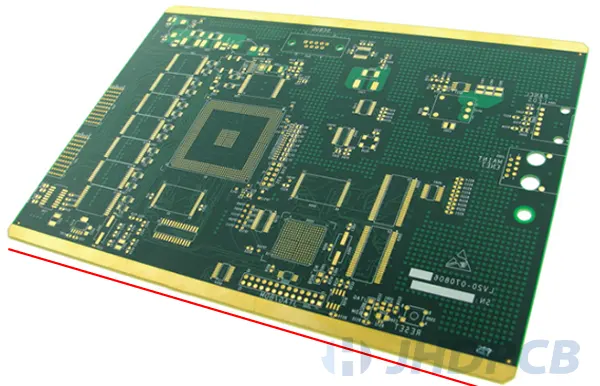
Limitations of Wraparound Edge Plating.
The limitation is that Wrap around-edge plating cannot be fabricated in a large volume, but it’s possible for a single board or a prototype. Because the metallization of the edge of the PCB around its perimeter is involved in wrap-around edge plating. The manufacture of large PCB volumes on panels aggravates the difficulty of the achievement of wrap-around edge metallization.
A panel is generally composed of multiple boards and these boards are putted together to achieve the simplified manufacture process. This state will last until to the subsequent stage, which is the assembly and fabrication process. As a result, it’s impossible to achieve the edge plating of sharing edges between boards.
What is Tooth Edge Plating?
Tooth edge plating can be called castellated edge plating, which refers to plating a variety of drilled holes and making their center points along the PCB outline. The space of plated half-holes between them was left after when these holes are routed through. The installation of the pre-assembled components to either a region of a greater board or a small breakout board was generally facilitated by castellations. The method of the half-holes being spaced on the castellated board is often used to achieve alignment with surface mount pads on the greater board.
Under the condition of two boards being connected, the excessive mating soldering surface was offered by each half holes barrel plating. For the purpose of forming a more secure joint than a basic butt joint, the half-hole’s barrel will be wicked up by the assembly solder.
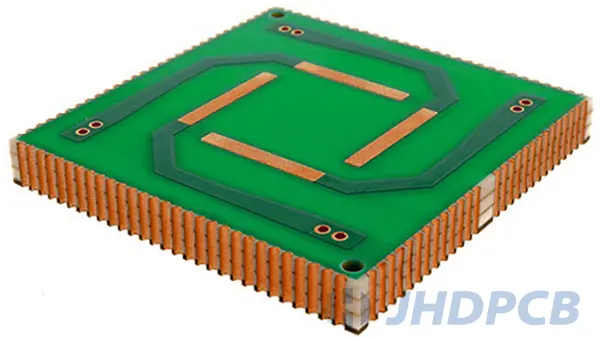
Technical difficulties in tooth edge plating.
Beyond that, castellated edge plating has strict and close tolerance and it’s hard and tricky to abide by. This circumstance can be deteriorated by small holes and have a high sensitivity to tolerance deviations. The common issues that we can encounter are as follow:
- The misalignment can be caused by even a slight deviation when the system has small design aspects and strict tolerances.
- Such deviation can be seen as well when the PCB experience diverse manufacturing processes. The reduced work area for edge plating amounting is the result.
- When the board edge is vertical to the drilled holes and these holes are not secure, they might slide out at the last stage of routing. This can encroach into the split holes and damage the inter-layer construction then impede the entire process.
Finally, let’s see the special distinctions of tooth edge plating. Tooth edge plating includes the connection by consecutive plating of drilled holes, rather than the total covering of the circuit board’s edges. These plated holes extend from the place they are routed to the PCB boundary. Tooth edge plating is especially helpful under the situation of using peripheral board to connect. Such peripheral installations can serve as slaves or modules to enhance the installation’s performance. The situation of the castellations being organized can lead to the result that the castellations are aligned with the landing pads of the main board.
Edge plating helps to establish a strong connection to the PCB and can reduce the chance of equipment failure. Therefore, edge plating is widely used in applications that require better connection support and has become a common practice in PCB manufacturing. JHD has the most advanced PCB edge plating process line, and has accumulated a lot of experience in PCB edge plating. This allows us to address production issues in edge plating.
With proper execution of the PCB edge plating process, our well-trained workers can maintain the quality of the PCB edge plating within tight tolerances. Strict impedance control management system can effectively avoid glitches or short circuits. For technical details of PCB edge plating process, please feel free to contact our customer service team. JHD is not stingy to share his experience to help solve the problems you face.





